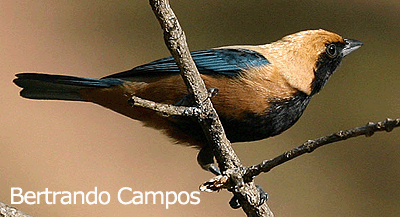
Burnished-buff Tanager
[order] Passeriformes | [family] Thraupidae | [latin] Tangara cayana | [UK] Burnished-buff Tanager | [FR] Calliste passevert | [DE] Isabelltangare | [ES] Tangara Monjita | [IT] Tangara della Cayenna | [NL] Sabeltangare
Subspecies
| Genus | Species | subspecies | Breeding Range | Breeding Range 2 | Non Breeding Range |
| Tangara | cayana | SA | Amazonia, se, sc SA | ||
| Tangara | cayana | cayana | |||
| Tangara | cayana | chloroptera | |||
| Tangara | cayana | flava | |||
| Tangara | cayana | fulvescens | |||
| Tangara | cayana | huberi | |||
| Tangara | cayana | margaritae | |||
| Tangara | cayana | sincipitalis |
Physical charateristics
The male crown is rufous with a black masked face at eyes and cheecks. Rest of the face and ipper parts are greenish gold. Wings and tail dusky with greenish blue edges. Underparts shiny buff.
Listen to the sound of Burnished-buff Tanager
[audio:http://www.aviflevoland.nl/sounddb/B/Burnished-buff Tanager.mp3]
Copyright remark: Most sounds derived from xeno-canto
| wingspan min.: | 0 | cm | wingspan max.: | 0 | cm |
| size min.: | 13 | cm | size max.: | 15 | cm |
| incubation min.: | 0 | days | incubation max.: | 0 | days |
| fledging min.: | 0 | days | fledging max.: | 0 | days |
| broods: | 1 | eggs min.: | 2 | ||
| eggs max.: | 3 |
Range
It is found in the coastal Guianas of Guyana, Suriname and French Guiana with Venezuela and central Colombia; also the Amazon River outlet region of Brazil, (Amapa and Para), the cerrado, the caatinga, and regions of Bolivia, Paraguay and northeast Argentina. There are two subspecies of the Burnished-buff Tanager, separated by being north of the Amazon River and southeastwards; the species is dimorphic, the female being of duller, yet buff plumage.
The Burnished-buff Tanager is found in areas of the Amazon Basin, specifically the outlet region of the Amazon River, and the upstream drier regions of watersheds in the southeast Amazon Basin bordering the Cerrado. The largest range of the bird?(the southern subspecies), is in Central-West-Southeast Region, Brazil and contiguous with Northeast Region, Brazil, the cerrado and the caatinga regions.
Habitat
Its natural habitats are subtropical or tropical moist lowland forests, dry savanna, subtropical or tropical dry shrubland, and subtropical or tropical seasonally wet or flooded lowland grassland. They are found in savannas, cerrado, gallery woodland and forest borders.
Reproduction
The nest, is an open cup made out of leaves, roots and lined with fine roots. It is placed in branches with 2 meter above ground, in low and isolated trees. It is mainly built by the feamle, but males do assist. The 2 eggs are incubated by the female. During this period the male remains in the neighborhood of the nest and sometimes feeda the female. The male also assists in the feeding of the chicks. No data on incubation or fledging period
Feeding habits
Mostly found alone or in pairs forages for berries and fruit. Also gleans foliage for insects.
Conservation
This species has a large range, with an estimated global Extent of Occurrence of 5,700,000 km². The global population size has not been quantified, but it is believed to be large as the species is described as ‘frequent’ in at least parts of its range (Stotz et al. 1996). Global population trends have not been quantified, but the species is not believed to approach the thresholds for the population decline criterion of the IUCN Red List (i.e. declining more than 30% in ten years or three generations). For these reasons, the species is evaluated as Least Concern.

Migration
Sedentary throughout range
Distribution map

Literature
Title Ecological relationships between feather mites (Acari) and wild birds of
Emberizidae (Aves) in a fragment of Atlantic Forest in northeastern Brazil
Emberizidae (Aves) in a fragment of Atlantic Forest in northeastern Brazil
Author(s): Rachel M. de Lyra-Neves Angela M. Isidro de Farias & Wallace R. Telino-Junior
Abstract: The objective of this study was to investigate fea..[more]..
Source: Revista Brasileira de Zoologia 20 (3): 481-485, 2003
]]>
